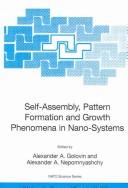| Listing 1 - 3 of 3 |
Sort by
|

ISBN: 1402043546 1402043554 940078855X 9786610427369 1280427361 Year: 2006 Volume: 218 Publisher: Dordrecht : Springer,
Abstract | Keywords | Export | Availability | Bookmark
 Loading...
Loading...Choose an application
- Reference Manager
- EndNote
- RefWorks (Direct export to RefWorks)
Nano-science and nano-technology are rapidly developing scientific and technological areas that deal with physical, chemical and biological processes that occur on nano-meter scale – one millionth of a millimeter. Self-organization and pattern formation play crucial role on nano-scales and promise new, effective routes to control various nano-scales processes. This book contains lecture notes written by the lecturers of the NATO Advanced Study Institute "Self-Assembly, Pattern Formation and Growth Phenomena in Nano-Systems" that took place in St Etienne de Tinee, France, in the fall 2004. They give examples of self-organization phenomena on micro- and nano-scale as well as examples of the interplay between phenomena on nano- and macro-scales leading to complex behavior in various physical, chemical and biological systems. They discuss such fascinating nano-scale self-organization phenomena as self-assembly of quantum dots in thin solid films, pattern formation in liquid crystals caused by light, self-organization of micro-tubules and molecular motors, as well as basic physical and chemical phenomena that lead to self-assembly of the most important molecule on the basis of which most of living organisms are built – DNA. A review of general features of all pattern forming systems is also given. The authors of these lecture notes are the leading experts in the field of self-organization, pattern formation and nonlinear dynamics in non-equilibrium, complex systems.
Natuurwetenschappen --- Physical sciences --- Sciences physiques --- Pattern formation (Physical sciences) --- Nanoscience. --- Formation des structures (Sciences physiques) --- Nanosciences --- Pattern formation (Physical sciences). --- Nanoscience --- Physical Sciences & Mathematics --- Sciences - General --- EPUB-LIV-FT Growth LIVPHYSI Nano-systems SPRINGER-B phenomena --- Nano science --- Nanoscale science --- Physics. --- Amorphous substances. --- Complex fluids. --- Biophysics. --- Biological physics. --- Statistical physics. --- Dynamical systems. --- Statistical Physics, Dynamical Systems and Complexity. --- Soft and Granular Matter, Complex Fluids and Microfluidics. --- Biophysics and Biological Physics. --- Dynamical systems --- Kinetics --- Mathematics --- Mechanics, Analytic --- Force and energy --- Mechanics --- Physics --- Statics --- Mathematical statistics --- Biological physics --- Biology --- Medical sciences --- Complex liquids --- Fluids, Complex --- Amorphous substances --- Liquids --- Soft condensed matter --- Natural philosophy --- Philosophy, Natural --- Dynamics --- Statistical methods --- Growth phenomena --- Nano-systems

ISBN: 1402036620 1402036639 9786610624362 1280624361 1402036590 Year: 2005 Volume: 206 Publisher: Dordrecht ; [London] : Springer,
Abstract | Keywords | Export | Availability | Bookmark
 Loading...
Loading...Choose an application
- Reference Manager
- EndNote
- RefWorks (Direct export to RefWorks)
Recently there have been profound developments in the understanding and interpretation of liquids and soft matter centered on constituents with sho- range interactions. Ionic soft matter is a class of conventional condensed soft matter with prevailing contribution from electrostatics and, therefore, can be subject to possible long-range correlations among the components of the - terial and in many cases crucially affecting its physical properties. Among the most popular representatives of such a class of materials are natural and synthetic saline environments, like aqueous and non-aqueous electrolyte - lutions and molten salts as well as variety of polyelectrolytes and colloidal suspensions. Equally well known are biological systems of proteins. All these systems are examples of soft matter strongly in?uenced, if not dominated, by long-range forces. For more than half of century the classical theories by Debye and Hückel as well as by Derjaguin, Landau, Verwey and Owerbeek (DLVO) have been at the basis of theoretical physical chemistry and chemical engineering. The substantial progress in material science during last few decades as well as the advent of new instrumentation and computational techniques made it apparent that in many cases the classical theories break down. New types of interactions (e.g. hydrodynamic, entropic) have been discovered and a number of questions have arisen from theoretical and experimental studies. Many of these questions still do not have de?nite answers.
Ionic solutions --- Soft condensed matter --- Matière molle (Physique) --- Solutions ioniques --- Congresses --- Congresses. --- Congrès --- Soft condensed matter. --- Atomic Physics --- Physics --- Physical Sciences & Mathematics --- Matière molle (Physique) --- Congrès --- EPUB-LIV-FT LIVPHYSI SPRINGER-B --- Solutions, Ionic --- Physics. --- Physical chemistry. --- Condensed matter. --- Amorphous substances. --- Complex fluids. --- Biophysics. --- Biological physics. --- Soft and Granular Matter, Complex Fluids and Microfluidics. --- Condensed Matter Physics. --- Physical Chemistry. --- Biophysics and Biological Physics. --- Ions --- Solution (Chemistry) --- Condensed matter --- Matter, Soft (Condensed matter) --- Matter, Soft condensed --- Soft matter (Condensed matter) --- Complex fluids --- Chemistry, Physical organic. --- Biological and Medical Physics, Biophysics. --- Chemistry, Physical organic --- Chemistry, Organic --- Chemistry, Physical and theoretical --- Biological physics --- Biology --- Medical sciences --- Chemistry, Theoretical --- Physical chemistry --- Theoretical chemistry --- Chemistry --- Condensed materials --- Condensed media --- Condensed phase --- Materials, Condensed --- Media, Condensed --- Phase, Condensed --- Liquids --- Matter --- Solids --- Complex liquids --- Fluids, Complex --- Amorphous substances

ISBN: 9781402050305 1402050283 9781402050282 1402050291 9786611043858 1281043850 1402050305 Year: 2006 Volume: v. 232 Publisher: Dordrecht : Springer,
Abstract | Keywords | Export | Availability | Bookmark
 Loading...
Loading...Choose an application
- Reference Manager
- EndNote
- RefWorks (Direct export to RefWorks)
This volume comprises the proceedings of a NATO Advanced Study Institute (ASI) held at Geilo, Norway, 11-21 April 2005, the eighteenth ASI in a series held every two years since 1971. The objective of this ASI was to identify and discuss areas where synergism between modern physics and biology may be most fruitfully applied to the study of bioprocesses for molecular recognition, and of networks for converting molecular reactions into usable signals and appropriate responses. Many fields of research are confronted with networks. Genetic and metabolic networks describe how proteins, substrates and genes interact in a cell; social networks quantify the interactions between people in the society; the Internet is a complex web of computers; ecological systems are best described as a web of species. In many cases, the interacting networks manifest so-called emergent properties that are not possessed by any of the individual components. This means that the detailed knowledge of the components is insufficient to describe the whole system. Recent work has indicated that networks in nature have so-called scale-free characteristics, and the associated dynamic network modelling shows unexpected results such as an amazing robustness against accidental failures, a property that is rooted in their inhomogeneous topology. Understanding these phenomena and turning them to use in chemical and biological threat detection and response will require exploring a wide range of network structures as well.
informatica --- Social sciences (general) --- Fluid mechanics --- General biophysics --- sociale wetenschappen --- biofysica --- materie (fysica) --- Computer science --- vloeistoffen --- biologische materialen --- Biosensors --- Biochemical engineering --- Biocapteurs --- Génie biochimique --- Congresses. --- Congresses --- Congrès --- EPUB-LIV-FT LIVPHYSI SPRINGER-B --- Biomaterials. --- Social sciences. --- Statistical physics. --- Complex Systems. --- Soft and Granular Matter, Complex Fluids and Microfluidics. --- Biological and Medical Physics, Biophysics. --- Social Sciences, general. --- Statistical Physics and Dynamical Systems. --- Physics --- Mathematical statistics --- Behavioral sciences --- Human sciences --- Sciences, Social --- Social science --- Social studies --- Civilization --- Biocompatible materials --- Biomaterials --- Medical materials --- Medicine --- Biomedical engineering --- Materials --- Biocompatibility --- Prosthesis --- Statistical methods --- Dynamical systems. --- Amorphous substances. --- Complex fluids. --- Biophysics. --- Biological physics. --- Bioartificial materials --- Hemocompatible materials --- Complex liquids --- Fluids, Complex --- Amorphous substances --- Liquids --- Soft condensed matter --- Dynamical systems --- Kinetics --- Mathematics --- Mechanics, Analytic --- Force and energy --- Mechanics --- Statics --- Biological physics --- Biology --- Medical sciences --- Biomaterials (Biomedical materials) --- Complex interconnected biosensor systems --- Bioprocesses --- Networks --- NATO
| Listing 1 - 3 of 3 |
Sort by
|

 Search
Search Feedback
Feedback About UniCat
About UniCat  Help
Help News
News